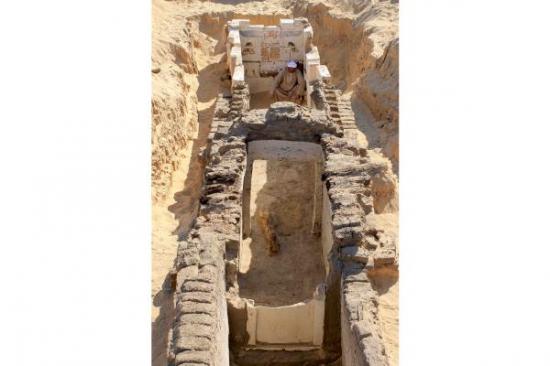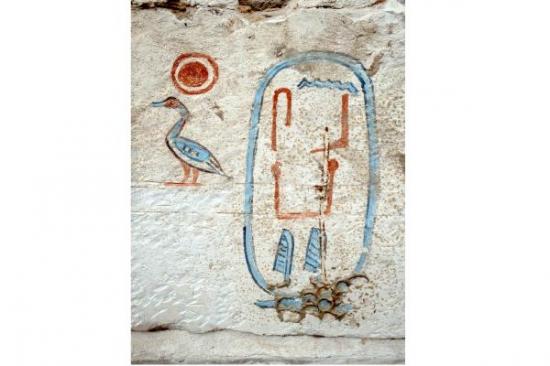Source - http://weekly.ahram.org.eg/News/5368/47/Lost-dynasty-revealed.aspx
The discovery of a previously unknown ancient Egyptian pharaoh has revealed evidence of a lost 3,600-year-old dynasty

At the small town of Abydos near the Upper Egyptian city of Sohag, US archaeologists are busy deciphering a critical era in ancient Egyptian history that took place between the Second Intermediate Period and the rise of the New Kingdom, reports Nevine El-Aref. According to Egyptologists, this period is known for its fragmentation and political conflict as the authorities at the time struggled against rival kingdoms in the north ruled by the Hyksos and in the south ruled from Thebes.

Cartouche with the name of king Senebkay
Earlier this month excavators from Pennsylvania University in the US led by Josef Wegner stumbled upon what is believed to be the tomb of a previously unknown ancient Egyptian pharaoh who ruled during a forgotten local dynasty called Abydos.
The existence of this dynasty, according to Wegner, was first put forward in 1997 by Kim Ryholt from the University of Copenhagen, but evidence to prove its existence was not found until the Penn team uncovered the name and tomb of one of the early kings of the Abydos Dynasty called Woseribre-Senebkay.
The story of this discovery, according to the Penn team report of which the Weekly has seen a copy, started last summer when the team discovered the 60-ton red quartzite sarcophagus of the founder of the 13th Dynasty, Sobekhotep I, during routine excavation work at the Middle Kingdom necropolis in Abydos near Sohag.
More excavations in the area uncovered the tomb of Sobekhotep I and fragments of his funerary stelae. A collection of burials belonging to royal figures of a later period, probably the Second Intermediate Period, was also found. Early studies revealed that the funerary collection of Sobekhotep I was reused by these later kings, one of them reusing a sarcophagus and another reusing wooden canopic jars.
During last winter’s archaeological season, the Penn team continued its excavations in the area surrounding Sobekhotep I’s tomb, eventually stumbling upon the tomb of one of the early kings of the forgotten Abydos Dynasty called Woseribre-Senebkay who ruled in 1650 BC during the Second Intermediate Period.
The tomb is modest and consists of four chambers with a decorated limestone burial chamber painted with scenes depicting the goddesses Nut, Nephthys, Selket, and Isis flanking the canopic shrine. Hieroglyphic texts bearing the names of the four sons of Horus and records of the pharaoh’s different titles identifying him as the “king of Upper and Lower Egypt, Woseribre, the son of Re, Senebkay” are engraved on the tomb’s walls.
The tomb was badly plundered in antiquity, and its funerary collection and equipment were stripped of their gilded surfaces. The Penn team succeeded in uncovering the remains of Senebkay’s skeleton amidst the debris of his fragmentary coffin, as well as his funerary mask and canopic chest carved in cedar wood.
Studies carried out on the skeleton by Penn graduate students Paul Verhelst and Matthew Olson indicate that he was a man of moderate height around 1,75 metres high and probably died in his mid to late 40s. Wegner said that studies had also revealed that the cedar wood beams used for the canopic chest had originally belonged to Sobekhotep I as some of the beams still bore his name, covered over by gilding.
“It is a very significant discovery,” Wegner said, adding that it not only provided evidence of a forgotten local ancient Egyptian dynasty and the location of its royal necropolis, but also highlighted the political and social condition of Egypt during the Second Intermediate Period.
He said that the existence of an independent Abydos Dynasty contemporary with the 15th (Hyksos in the north) and 16th and 17th (Theban kingdom in the south) Dynasties had first been hypothesised in 1997. The present discovery had confirmed this and identified the location of the royal necropolis at South Abydos in an area called Anubis-Mountain in antiquity.
Wegner said that about 16 royal tombs from the Abydos Dynasty spanning the period of 1650–1600 BCE had been found adjacent to the tombs of earlier Middle Kingdom pharaohs including Senwosret III (Dynasty 12, around 1880–1840 BCE) and Sobekhotep I (Dynasty 13 around 1780 BCE), and Senebkay appeared to be one of the earliest kings.
Wegner suggested that the forgotten pharaoh’s name may have appeared in a broken section of the famous Turin King List, a papyrus document dating to the reign of Ramses II and now exhibited in the Turin Museum, where two kings with the throne name “Woser...re” are recorded at the head of a group of more than a dozen kings, most of whose names are entirely lost.
“The reuse of the cedar beams of Sobekhotep I’s tomb by Senebkay to carve his canopic jars and the reuse of the quartzite sarcophagus by another Abydos Dynasty king who is not yet identified suggests limited resources and the isolated economic situation of the Abydos Kingdom,” Wegner said, adding that “continued excavations and studies in situ will reveal more of such a forgotten dynasty as well as shed more light on the political history and society of an important but poorly understood era of Ancient Egypt.”
Ali Al-Asfar, head of the Ancient Egyptian section at the ministry of state for antiquities (MSA), told the Weekly that he saw Senebkay as the founder of the 16th Dynasty and the discovery of this king and his tomb meant that the Hyksos had not extended their rule all over Egypt as the south was independent and reigned over by Theban kings.
Professor of Ancient Egypt archaeology at the Faculty of Archaeology at Cairo University Ahmed Saeed had a different opinion, however.
He said that the existence of the Abydos Dynasty was unproven and that Senebkay probably belonged to the 13th Dynasty as his tomb was found near the tomb of the 13th Dynasty pharaoh Sobekhotep I.
“More accurate studies should be carried out before any announcement of a forgotten dynasty is made because it is rare to find a royal tomb in Abydos,” Saeed said.